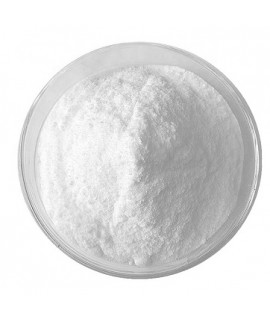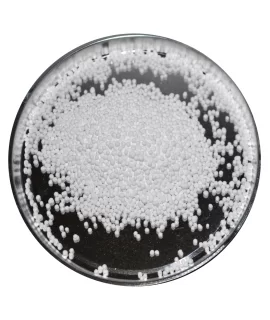TERT-BUTYLHYDROQUINONE (TBHQ, E319 food grade), kg
6.00 €
E319, CAS 1948-33-0, tert-butylhydroxyquinone, INCI TBHQ, tertiary butyl hydroxyphenol, butylhydroquinone, tert-butylhydroquinone, tertbutylhydroquinone
Parameter | Attribute |
TBHQ | E319, Tertiary-butylhydroxyquinone, Tertiary-butyl hydroxyquinol, Butylhydroquinone, Tertiary-butylhydroquinone, Tertiary Butylhydroquinone (TBHQ) |
Formula | C10H14O2 |
Structure |
|
IUPAC | 2-(1,1-Dimethylethyl)-1,4-benzenediol |
INCI | TBHQ |
CAS | 1948-33-0 |
Molar mass | 166.22 g/mol |
Density | 1,05 g/cm3 ( 20 °C) |
Solubility | Sparingly soluble in water: 1mg/L ( 20 °C) 50g/L ( 95 °C) Freely soluble in alcohol, ether, organic solvents |
Tert-butylhydroquinone (tBHQ) is widely used as a synthetic food antioxidant to protect oils and fats from oxidative deterioration and rancidity due to its strong lipid peroxidation activity.
In the food industry, TBHQ is used as a preservative for unsaturated vegetable oils and many edible animal fats. It does not change colour even in the presence of iron and does not alter the taste or odour of the material to which it is added. It can be combined with other preservatives such as butylated hydroxyanisole (BHA). As a food additive, its E number is E319. It is added to various foods. Its main advantage is a longer shelf life. TBHQ is a common antioxidant that prevents fat oxidation. Oxidation can cause foods to lose flavour, discolour and deplete nutritional value. Since oxidation can cause fats to go rancid, TBHQ can also help to extend shelf life and reduce food waste due to spoilage. TBHQ is often found in foods such as crackers, fats and oils, chips, doughnuts, some breads, popcorn, other snack foods, and pre-prepared frozen foods. TBHQ has been classified by the US Food and Drug Administration (FDA) as Generally Recognised as Safe or "GRAS". Stored fats and oils, along with foods containing these ingredients, can become rancid, stale or simply unappetizing over time, and TBHQ's antioxidant properties help to preserve these fats and oils by removing the oxygen they contain. In manufacturing, TBHQ is usually added to the lipid (fatty) phase. It can be used in combination with other common antioxidants such as BHT and BHA but not with propyl gallate (PG). In lipid-containing food formulations, TBHQ is highly effective due to the following properties:
- High antioxidant activity in cooking oils and fats.
- Similar to BHA and BHT in its oxidative capacity.
- Soluble in fat.
- Does not react with copper and iron and does not form complex compounds. .
- Does not fade the colour of foodstuffs.
- Does not cause off-flavours.
- Citric acid or monoglyceride citrates may be added to improve lipid stabilising properties.
TBHQ use levels in Europe and USA: Fats and oils 0.2% 200 mg/l, Bakery 0.2% 200 mg/l (only in cake mixes), Cereals 0.2% 200 mg/l (only pre-cooked cereals). TBHQ (E319) is considered safe in the European Union by the European Food Safety Authority with a tolerable daily intake of 0.7 mg/kg.
In cosmetics it is used as a fixative to reduce evaporation rate and improve stability. TBHQ is used in the manufacture of lipsticks, colognes, moisturisers and other make-up products. Its function in cosmetics is to stabilise the product so that the fatty ingredients in the formulation do not change colour, the fragrance does not change aromatic properties, and the creams do not change their rheological properties (flow, viscosity, stiffness). Essential functions of Tert-Butylhydroquinone (INCI)
- Antioxidant: Inhibits reactions stimulated by oxygen, thus preventing oxidation and rancidity
- Masking: Reduces or inhibits the odour or the main flavour of the product
- Perfume: Used in perfumes and aromatic raw materials
In biodiesel production, tertiary butyl hydroxynol is used as a stabiliser to inhibit autopolymerisation of organic peroxides. It is particularly widely used as an antioxidant in biodiesel. The use of antioxidants in biodiesel is particularly relevant when the feedstock is a waste oil, poor quality or old oil. Concentrations up to 1 kg of antioxidant per tonne of biodiesel are used.
In agriculture and horticulture, TBHQ is used as an ingredient in insecticides to prevent the active substances from becoming stale.
In oil production, TBHQ is used as a petroleum antioxidant and stabiliser. During extraction, oil contains high levels of unsaturated compounds which react very quickly with air and change their properties, thus losing valuable raw materials. The addition of an antioxidant preserves all the valuable components in the oil.
In the paint industry, butylhydroquinone is also added to varnishes and resins in order to maintain the rheological properties (viscosity, flow, stiffness, etc.) of the products unchanged, since the base of these products is of fatty origin, where, when combined with oxygen, the properties of the constituent components change.
Important: Add the item to your basket, fill in the recipient's details and confirm your order. Thank you!
To save your precious time, we will deliver your order to your address at a time convenient for You!
*- The pictures of the goods may not correspond to the actual appearance, colour, assembly or shape of the goods and their packaging. The information in the product description is of a general nature and may not correspond to the information on the packaging of the product and may not be the exact use of the product. The information given on the stocks and prices of goods may, in certain cases, differ from the actual prices and stocks of goods
**- The product complies with the requirements for food additive E319 but is not intended for use as a food additive.
Signal word: WARNING |
Hazard icons:
|
Danger phrases: H302 Harmful if swallowed H315 Irritating to skin H319 Severely irritating to eyes H335 May cause respiratory irritation. |
Precautionary statements: P261 Avoid inhalation of vapours and aerosols P305+P351+P338 IN EYES: Wash gently with water for several minutes. Remove contact lenses, if present and if easy to do so. Continue to wash eyes. P501 Dispose of contents/container in accordance with legal procedures |
Related products
(8 other products in the same category)













